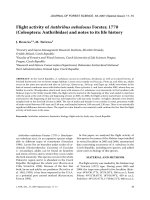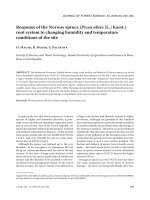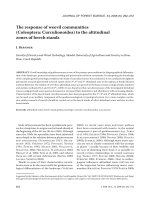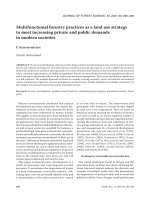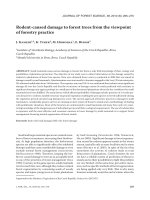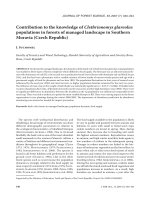Báo cáo lâm nghiệp: "Physiological responses to air pollutants" potx
Bạn đang xem bản rút gọn của tài liệu. Xem và tải ngay bản đầy đủ của tài liệu tại đây (425.16 KB, 7 trang )
Physiological
responses
to
air
pollutants
G.
Halbwachs
Zentrum
fur
Umwelt-
und
Naturschutz,
Universitit
fur
Bodenkultur,
Wien,
Osterreich
When
investigating
the
phenomenon
of
large
scale
’forest
decline’,
particularly
its
appearance
in
so-called
clean
air
regions,
plant
physiology
has
gained
considerable
importance.
Especially
tree
physiology,
which
deals
with
the
life
processes
of
trees,
has
again
become
interesting
not
only
for
scientists,
but
also
for
the
ecologi-
cally
conscious
public
(Eschrich,
1987).
Trees
are
long-lived
organisms
which
over
many
decades
pass
through
various
stages
of
development
(seedling,
sapling,
young
growth
and
old
growth),
each
with
its
own
distinctive
physiological
charac-
teristics.
In
addition
to
these
variations,
sensitivity
varies
during
the
daily
and
annual
rhythm.
Since
trees
tower
over
all
other
forms
of
vegetation,
they
have
a
definite
advantage
in
the
struggle
for
light.
Furthermore,
they
have
evolved
a
system
of
compartmentalization
which
allows
them
the
loss
of
larger
plant
parts
without
substantially
affecting
their
chances
for
survival.
Because
of
these
attributes
they
possess
a
dominant
position
in
a
forest.
Nevertheless,
the
term
forest
not
only
includes
all
closely
interacting
trees
locat-
ed
in
a
defined
area,
but
it
also
includes
the
complex
structure
of
interactions
be-
tween
trees,
bushes,
herbs,
animals,
the
soil
including
the
organisms
that
live
in
and
on
it
and
the
special
climatic
condi-
tions.
In
the
forest
ecosystem
with
its
diversity
in
vegetation
and
animal
life,
a
near
equilibrium
is
reached
between
de-
composition
and
synthesizing
processes.
Even
though
this
equilibrium
is
rather
labile
because
of
permanent
natural
changes,
it
still
works
very
efficiently
to
maintain
nutrients
in
the
system.
An
addi-
tional
attribute
is
the
ability
of
trees,
whose
tops
are
strongly
coupled
with
the
atmo-
sphere,
to
filter
out
dust
and
trace
ele-
ments,
which
;are
then
integrated
into
the
nutrient
cycle.
It
is
precisely
this
large
fil-
tering
capacity
that
appears
increasingly
to
be
a
disadvantage
for
the
forest
in
light
of
the
present
atmosphere
load
of
pol-
lutants.
Because
of
some
of
the
attributes
alrea-
dy
discussed,
it
is
understandable
that
trees
have
not
often
been
studied
by
plant
physiologists.
Some
of
the
difficulties
in
investigating
trees
range
from
the
carrying
out
of
experiments
on
tall
trees
and
forest
stands
to
the
interpretation
of
the
gathered
data.
Small
trees,
which
are
easy
to
han-
dle
as
test
objects,
are
usually
only
a
few
years
old
and,
therefore,
are
not
com-
parable
in
their
physiological
reactions
to
mature
trees
in
forest
stands.
Large
trees,
however,
are
practically
impossible
to
place
in
an
experimental
situation.
This
is
especially
true
from
an
aboveground
microclimatic
perspective.
James
Bonner
once
said,
&dquo;everything
that
can
be
done,
can
be
done
better
with
peas&dquo;,
but,
unfor-
tunately,
this
does
not
apply
to
the
study
of
woody,
long-lived
plants.
The
central
problem
of
experimental
forest
research
lies
in
the
decision
wheth-
er
one
carries
out
the
experiments
in
labs
or
chambers
with
artificial
but
controlled
conditions
or
undertakes
field
studies
with
realistic
conditions,
but
with
the
influence
of
many
uncontrollable
environmental
fac-
tors.
Whenever
the
clarification
of
special
questions
or
specific
mechanisms
concer-
ning
tree
damage
is
desired,
the
first
type
of
experiments
would
be
chosen.
The
results
of
fumigation
experiments
on
young
plants
could
be
utilized
for
inter-
preting
some
effects
when
air
pollution
is
the
dominant
stress
factor.
This
experi-
mental
approach
is
not
adequate
for
more
precise
analysis
of
the
interaction
between
air
pollution
and
the
forest
ecosystem,
where
not
only
emission
stress
is
at
hand,
but
a
complex
system
involving
many
stress
factors
(Lefohn
and
Krupa,
1988).
Also,
fumigation
experiments
using
open-
topped
chambers
may
not
correctly
model
the
coupling
between
forest
trees
and
the
atmosphere
(as
reported
by
Dr.
Jarvis
in
these
proceedings).
This
is
surely
a
reason
why
today
not
enough
tree-specific
physiological
infor-
mation
is
available
which
is
needed
to
explain
the
intricate
phenomenon
of
’forest
decline’
in
its
varied
manifestations.
The
fact
that
knowledge
about
physio-
logical
behavior
of
trees
has
become
of
great
importance
today,
leads
to
two
consequences
for
tree
physiologists
-
a
pleasant
and
an
unpleasant
one.
The
pleasant
consequence
is
not
only
the
increased
appreciation
of
tree
physiology,
but
also
the
increase
in
funds
for
research.
The
latter
aspect
has
even
allured
some
physiologists
away
from
peas
-
though
perhaps
only
for
a
short
period
of
time.
The
unpleasant
consequence
manifests
itself
in
the
growing
impatience
of
politi-
cians
and
the
general
public.
They
expect
tree
physiologists
to
bring
forth
prompt
and
clear
statements
about
the
causes
of
the
present
forest
damage.
From
what
has
already
been
said
about
research
prob-
lems
with
trees,
it
is
evident
that,
in
tree
physiology,
it
seems
to
be
almost
impos-
sible
to
get
quickly,
universally
applicable
research
results.
’Forest
decline’
is
a
com-
plex
phenomenon
which
has
only
surfaced
as
a
major
research
focus
in
the
past
few
years.
Without
delving
into
a
discussion
about
the
causes
of
’forest
decline’,
most
scien-
tists
agree
that
diverse
air
pollutants
of
the
acidic
or
oxidative
type
play
a significant
role
in
this
problem.
These
air
pollutants
along
with
other
abiotic
and
biotic
stresses
account
for
those
conditions
which
could
inhibit
phy-
siological
processes.
Since
these
physio-
logical
processes
determine
the
quantity
and
quality
of
tree
growth
limited
by
gene-
tic
potential
and
directed
by
environmental
conditions,
physiology
as
a
science
should
be
strongly
anchored
in
forestry.
Unfortu-
nately,
the
role
of
physiology
in
this
branch
of
science
-
as
Kramer
(1986)
regrettably
determined
-
was
often
not
correctly
understood.
This
has
turned
out
to
be
a
disadvantage
because
it
is
difficult
to
dis-
cuss
changes
when
one
does
not
possess
sufficient
information
about
the
original
conditions.
For
example,
the
first
signs
of
injury
from
’forest
decline’
have
been
found
at
the
macroscopic
level,
even
though
the
causes
of
these
disturbances
are
found
on
the
cellular
and
subcellular
levels.
An
important
task
for
the
plant
phy-
siologist
is
to
determine
the
mechanisms
responsible
for
such
damage
and,
if
pos-
sible,
also
the
primary
cause
of
it.
Physio-
logical
criteria,
however,
should
also
help
to
quantify
and
differentiate
the
damage
to
trees.
Above
that,
they
should
be
capable
of
following
the
course
of
destruction
and
its
effects
from
the
primary
injury,
which
should
be
detected
as
early
as
possible,
until
the
death
of
the
tree.
Reports
have
only
recently
been
released
concerning
physiological
and
biochemical
reactions
of
trees
and
shrubs
to
different
air
pollutants
(Kozlowski
and
Constantinidou,
1986)
as
well
as
physiological
and
biochemical
changes
within
damaged
trees
(Lange
and
Zellner,
1986;
Ziegler,
1986)
and
about
the
effects
of
gaseous
air
pollutants
on
forest
trees
from
a
plant
physiological
point
of
view
(Weigel
et
aL,
1989).
The
topics
discussed
mainly
in
these
papers
are
listed
in Table
I.
The
various
test
parameters
listed
in
the
table
changedl
in
the
presence
of
air
pollu-
tants,
however,
the
mechanism
of
change
has
not
been
specified.
Many
of
these
parameters
also
behave
in
a
similar
way
when
exposed
to
other
abiotic
or
biotic
stresses,
such
as
frost,
heat,
light,
drought
as
well
as
fungus
infection
and
insect
attack.
The
isolated
observation
of
these
parameters
is
not
useful
when
trying
to
place
the
reaction
on
a
whole
tree
basis.
For
example,
it
is
unrealistic
to
determine
the
vitality
of
;a
whole
tree
or
canopy
from
changes
in
chlorophyll
fluorescence
in
a
few
needles.
In
order
to
be
able
to
apply
plant
physiological
criteria
as
an
effective
determinant,
the
suggestions
from
Weigel
and
Jager
(1985)
to
compile
and
combine
various
physiological,
biochemical
and
chemical
parameters
to
build
a
chain
of
evidence
should
be
tried.
In
this
manner,
at
least
an
indication
of
overlying
toxicity
principles
can
be
achieved,
such
as
the
general
acid
effect,
the
formation
of
radi-
cals
and
the
role
they
play as
well
as
the
destruction
of
membrane
systems.
Unalterable
assumptions
for
the
investi-
gation
of
pollution
effects
using
physiologi-
cal
and
biochemical
parameters
must
include
the
local
emission
situation
and
the
consideration
of
the
climatic
condi-
tions.
The
knowledge
of
reactions
which
take
place
on
the
plant’s
surface
and
inside
it
allows
inferences
about
the
various
resis-
tance
mechanisms
of
trees
in
contact
with
air
pollutants.
According
to
Levitt
(1980),
two
strategies
can
be
distinguished:
avoid-
ance
and
tolerance.
While
avoidance
stra-
tegies
include
the
cuticle
and
the
stomata,
tolerance
plays
a
part
whenever
gaseous
air
pollutants
penetrate
into
the
leaves
or
needles.
A
few
examples
will
demonstrate
this.
The
cuticular
wax
layers
of
the
leaves
from
trees
present
themselves
as
the
pri-
mary
target
for
air-borne
pollutants
(Huttu-
nen
and
Soikkeli,
1984).
These
layers
function
as
a
protection
against
wind,
non-
stomatal
transpiration,
frost,
pathogenic
and
insect
attack
as
well
as
against
the
penetration
of
air
pollutants.
Their
erosion
and
destruction
introduce,
on
the
one
hand,
a
loss
of
the
barrier
which
prohibits
the
intake
of
pollutants
and,
on
the
other
hand,
facilitates
the
leaching
of
essential
nutrients,
leading
to
an
increase
in
the
effects of
the
damage
already
done
by
pollutants.
Destruction
of
the
cuticle
has
been
observed
after
the
impact
of
various
acidic
air
pollutants
(Ulrich,
1980;
Huttu-
nen
and
Laine,
1983;
Godzik
and
Halb-
wachs,
1986),
even
though
this
has
often
been
discussed
in
connection
with
ozone
penetration.
According
to
Baig
and
Tranquillini’s
(1976)
observations
in
the
Alps,
the
thickness
of
the
cuticle
from
spruce
and
stone
pine
needles
decreases
as
the
elevation
and
wind-exposure
increase,
which
is
at
the
same
time
connected
with
a
higher
transpiration
rate.
These
factors
determine
not
only
the
tim-
ber
line
in
temperate
zones,
but
could
also
be
used
to
explain
the
often
observed
exceptional
sensitivity
of
trees
in
the
ridge
areas
of
mountains.
The
ozone
concentra-
tions
which
generally
increase
with
the
elevation
(Smidt,
1983;
Bucher
et
al.,
1986)
are
correlated
with
a
reduced
quan-
tity
and
poorer
quality
of
cuticle.
Therefore,
these
ozone
concentrations
can
lead
to
re-
latively
severe
damage
to
trees,
especially
under
unfavorable
weather
conditions
and
shortening
of
the
vegetation
period.
The
stomata
can
play
a role
similar
to
the
cuticle
with
respect
to
the
avoidance
of
absorption
of
gaseous
substances,
when
the
absorbed
substance
causes
the
sto-
mata
to
close.
Indeed,
from
the
studies
of
Black
(1982)
and
Mansfield
and
Freer-
Smith
(1984),
it
has
been
shown
that
sto-
mata
can
open
or
close
as
a
result
of
the
penetration
of
pollutants.
Considering
the
complexity
of
stomatal
function,
it
is
hard
to
make
general
statements
about
the
behavior
of
stomata
in
a
certain
emission
situation,
particularly
for
field
studies.
The
results
of
changes
in
stomatal
aperture
or
regulation -
for
instance,
reduction
of
pol-
lution
intake
coupled
with
a
reduced
C0
2
absorption
or
an
increase
in
transpiration
which
leads
to
an
excessive
water
loss -
both
could
greatly
affect
the
plant’s
metabolism.
Only
after
the
penetration
of
wet
or
dry
deposited
pollutants
through
the
cuticle
or
the
stomata
are
metabolic
processes
affected
both
physically
and
biochemically.
These
processes
considered
together
form
the
internal
resistance
(H511gren,
1984;
Unsworth,
1981
The
magnitude
of
the
internal
resistance
is
responsible
for
the
tolerance
of
a
plant
species
with
re-
spect
to
air
pollutants.
This
internal
resis-
tance
is
determined
among
other
things
by
the
solubility
of
each
pollutant
in
the
water
of
the
cell
wall,
which,
when
considered
singly,
could
be
used
to
rank
the
internal
toxicity
of
the various
pollutants.
Also
vital
for
the
plant’s
tolerance
strategy
is
its
abili-
ty
either
to
degrade
the
penetrated
pol-
lutant
or
to
inactivate
it
through
chemical
binding
or
to
metabolize
it
into
non-toxic
reaction
products.
The
latter
case
is
likely
with
those
pollutants
containing
essential
elements,
such
as
S0
2
or
NO,.
Ozone
is
an
example
of
a
pollutant
which
degrades
inside
the
plant.
Even
though,
when
compared
to
S0
2,
N0
2
or
HF,
ozone
demonstrates
less
solubility,
its
high
chemical
reactivity
with
unsaturated
fatty
acids,
aromatic
compounds
and
sulf-
hydril
groups
necessitates the
mainte-
nance
of
a
steep
concentration
gradient
between
the
outside
air
and
the
inside
of
the
plant.
Various
radicals
also
take
part
in
the
phytotoxic
effect
of
ozone
(Tingey
and
Taylor,
1982;
Elstner,
1984).
They
are
not
only
a
result
of
the
reaction
of
ozone
mole-
cules
with
sulfhydril
groups
or
aromatic
and
olefinic
compounds,
but
also
stem
from
reactions
of
ozone
with
the
water
in
the
cell
wall.
Equally
possible
is
the
forma-
tion
of
hydroxyl-,
hydroperoxy-
and
super-
oxide
anion
radicals.
The
reactions
of
ozone
and
radical
oxygen
compounds
with
the
unsaturated
fatty
acids
of
the
biomem-
brane
lead
to
the
formation
of
lipid
radicals
and,
in
the
presence
of
oxygen,
lipid
peroxides
and
lipid
hydroperoxides (Bus
and
Gibson,
1979;
Halliwell
and
Gutte-
ridge,
1985).
Elstner
(1984)
takes
the
pro-
cess
of
lipid
peroxidation
as
the
initial
reaction
for
destruction
of
the
membrane
system,
which
is
responsible
for
the
life
preserving
compartmentalization
of
the
cell.
The
process
of
the
destruction
of
the
membrane
promotes
both
the
damaging
of
cuticular
wax
and
the
leaching
of
nutrients.
Since
radicals
are
also
found
in
normal
metabolism,
cells
have
developed
a
me-
chanism
to
>eliminate
them.
Enzymes,
such
as
superoxide
dismutase
(SOD),
catalase
and
peroxidase,
or
molecules
produced
by
the
cell
itself,
such
as
ascor-
bate,
which
acts
as an
anti-oxidant,
play
a
decisive
role
in
the
plant’s
detoxification
system
and,
therefore,
also
in
its
toler-
ance.
The
increase
in
SOD
found
in
poplar
leaves
as
well
as
pine
and
spruce
needles
after
fumigation
and
also
in
’forest
decline’
areas
points
to
a
participation
of
the
oxy-
gen
radical
in
the
damaging
of
trees.
Fluoride-con!taining
air
pollutants
serve
as
an
example
of
how
penetrated
toxic
ions
in
the
cell
are
taken
out
of
the
plant’s
metabolism
by
chemical
binding,
for
example,
with
Ca
and
Mg
cations.
The
tolerance
of
forest
trees
with
re-
spect
to
sulfur-
and
nitrogen-containing
air
pollutants
is
dependent
upon
their
ability
to
transform
these
compounds,
so
that
they
can
be
utilized
in
their
own
metabo-
lism.
The
oxidation
of
sulfur
to
sulfate
occurs
either
c!nzymatically
or
in
a
radical
chain
reaction.
The
increases
in
nitrite-
and
nitrate-reductase
activities
after
N0
2
impact
also
indicate
a
change
in
metabo-
lism,
as
in
the
increase
of
sulfur-containing
glutathione
after
S0
2
impact
(Wellburn,
1982;
Grill
et
a,L,
1982).
The
synergistic
effects
observed
with
many
pollutant
combinations
are
more
understandable
when
considering
that
the
detoxification
mechanism
for
one
of
the
pollutants
may
be
blocked
in
its
function
by
the
other
one.
The
demand
on
scientists
from
the
applied
areas
of
forestry
to
contribute
more
to
the
solution
of
real
problems
concerning
forests
cannot
be
quickly
ful-
filled
by
tree
physiologists
because
of
the
difficulties
in
experimentation,
as
demon-
strated
at
the
beginning
of
this
paper.
A
step
in
the
right
direction
has
been
the
realization
that
’forest
decline’
is
not
a
monocausal
problem.
Each
new
bit
of
information
acquired
in
tree
physiology
is
of
scientific
importance,
when
we
keep
in
mind
that
it
represents
only
a
small
part
of
a
complex
phenomenon.
References
Baig
M.N.
&
Tranquillini
W.
(1976)
Studies
on
upper
timber
line:
morphology
and
anatomy
of
Norway
spruce
(Picea
abies)
and
stone
pine
(Pinus
cembra)
needles
from
various
habitat
conditions.
Can.
J.
Bot.
54, 1622-1632
Black
V.J.
(1982)
Effects
of
sulphur
dioxide
on
physiological
processes
in
plants.
In:
Effects
of
Gaseous
Air
Pollutants
in
Agriculture
and
Hor
ticulture.
(M.H.
Unsworth
&
Ormrod
D.P.,
eds.),
Butterworths
Scientific,
London,
pp.
67-91
Bucher
J.B.,
Landolt
W.
&
Bleuler
P.
(1986)
Ozonmessungen
auf
dem
r6tiboden
ob
g6sche-
nen.
Schweiz.
Z.
Forstwes.
137,
607-621
Bus
J.S.
&
Gibson
J.E.
(1979)
Lipid
peroxida-
tion
and
its
role
in
toxicology.
In:
Reviews
in
Biochemical
Toxicology.
(Hodgson,
Bent
&
Phil-
pot,
eds.),
Elsevier
North
Holland,
pp.
125-149
Elstner
E.F.
(1984)
Schadstoffe,
die
Ober
die
luft
zugefuhrt
werden.
In:
Pflanzentoxikologie.
(Hock
B.
&
Elstner
E.F.,
eds.),
Bibliogra-
phisches
Institut
Wissenschaftsverlag.
Mann-
heim,
pp. 67-94
Eschrich
W.
(1987)
Was
wissen
wir
von
der
physiologie
der
bdume?
AFZ 18,
449
Godzik
St.
&
Halbwachs
G.
(1986)
Structural
alterations
of
Aesculus
hippocastanum
leaf
sur-
r.
face
by
air
pollutants.
Z.
Pflanzenkrankh.
Pflanzenschutz.
93,
590-596
Grill
D.,
Esterbauer
H.
&
Hellig
K.
(1982)
Fur-
ther
studies
on
the
effect
of
S0
2
-pollution
on
the
sulfhydril-system
of
plants.
Phytopathol.
Z.
104, 264-271
Hiligren
J.E.
(1984)
Photosynthetic
gas
ex-
change
in
leaves
affected
by
air
pollutants.
In:
Gaseous
Air
Pollutants
and
Plant
Metabo-
lism.
(Koziol
M.J.
&
Whatley
F.R.,
eds.),
Butter-
worths
Scientific,
London,
pp.
131-146
Halliwell
B.
&
Gutteridge
J.M.C.
(1985)
In:
Free
Radicals
in
Biology
and
Medicine.
Clarendon
Press
Huttunen
S.
&
Laine
K.
(1983)
Effects
of
air-
borne
pollutants
on
the
surface
wax
structure
of
Pinus
sylvestris
needles.
Ann.
Bot.
Fenn.
20,
79-86
Huttunen
S.
&
Soikkeli
S.
(1983)
Effects
of
various
gaseous
pollutants
on
plant
cell
struc-
ture.
In:
Gaseous
Air
Pollutants
and
Plant
Metabolism.
(Koziol
M.J.
&
Whatley
F.R.,
eds.),
Butterworths
Scientific,
London,
pp.
117-127
Kozlowski
T.T.
&
Constantinidou
H.A.
(1986)
Responses
of
woody
plants
to
environmental
pollution.
Part
I.
Sources
and
types
of
pollutants
and
plant
responses.
For.
Abstr.
47,
5-51
Kramer
P.J.
(1986)
The
role
of
physiology
in
forestry.
Tree PhysioL
2, 1-16
6
Lange
O.L.
&
Zellner
H.
(1986)
Physiologische
verdnderungen
bei
geschadigten
baumen -
zusammenfassende
bewertung
der
seminarer-
gebnisse.
Statusseminar
Wirkungen
von
Luft-
verunreinigungen
auf
Waldblume
und
Wald-
b6den,
Kernforschungsanlage
Juiich,
326-338
Lefohn
A.S.
&
Krupa
S.V.
(1988)
Acidic
precipi-
tation.
A
Summary
of
the
Proceedings
of
the
APCA
International
Conference
1987.
J.
Air
Pollut
Control Assoc.
38,
766-776
Levitt
J.
(1980)
In:
Responses
of
Plants
to
Environmental
Stresses.
Academic
Press,
New
York,
pp.
697
Mansfield
T.A.
&
Freer-Smith
P.H.
(1984)
The
role
of
stomata
in
resistance
mechanisms.
In:
Gaseous
Air
Pollutants
and
Plant
Metabolism.
(Koziol
M.J.
&
Whatley
F.R.
eds.),
Butterworths
Scientific,
London,
pp.
131-146
Smidt
St.
(1983)
Ober
das
auftreten
von
ozon
und
stickstoffoxiden
in
waldgebieten
Oster-
reichs.
Eur.
J.
For.
Pathol.
13, 133-141
Tingey
D.T
&
Taylor
G.E.
Jr.
(1982)
Variation
in
plant
response
to
ozone:
a
conceptual
model
of
physiological
events.
In:
Effects
of
Gaseous
Air Pollutants
in
Agriculture
and
Horticulture.
(Unsworth
M.H.
and
Ormrod
D.P.,
eds.),
Butterworths
Scientific,
London,
pp. 111-138
Ulrich B.
(1980)
Die
wg
lder
in
mitteleuropa:
mef3ergebnisse
ihrer
umweltbelastung,
theorie
ihrer
gefdhrdung,
prognose
ihrer
entwicklung.
AFZ
(MOnchen)
35, 1198-1202
Unsworth
M.H.
(1981)
The
exchange
of
carbon
dioxide
and
air
pollutants
between
vegetation
and
the
atmosphere.
In:
Plants
and
their
Atmospheric
Environment.
21st
Symposium
of
the
British
Ecological
Society.
(Grace
J.,
Ford
E.D.
&
Jarvis
P.G.,
eds.),
Blackwell
Scientific
Publ.,
Oxford,
pp.
111-138
Weigel
H.J.
&
Jager
H.J.
(1985)
Physiologische
und
biochemische
verfahren
zum
nachweis
von
schadstotfwirkungen.
Staub-Reinhalt.
Luft
45,
269-271
Weigel
H.J.,
Halbwachs
G.
&
Jager
H.J.
(1989)
The
effects
of
air
pollutants
on
forest
trees
from
a
plant
physiological
view.
Z.
Pflanzenkr.
Pllanzenschutz 96,
203-217
7
Weliburn
A.R.
(1982)
Effects
of
S0
2
and
N0
2
on
metabolic
function.
In:
Effects
of
Gaseous
Air
Pollution
in
Agriculture
and
Horticulture.
(Unsworth
M.H.
&
Ormrod
D.P.,
eds.),
Butter-
worths
Scientific,
London,
pp.
169-187
Ziegler
H.
(1986)
Biochemische
veranderungen
bei
geschadigten
baumen -
zuzammenfassen-
de
bewertung
deir
seminarergebnisse.
Status-
seminar
Wirkungen
von
Luftverunreinigungen
auf
waldbaume
und
Waldboden.
Kernfor-
schungsanlage
Jiilich.
339-344
